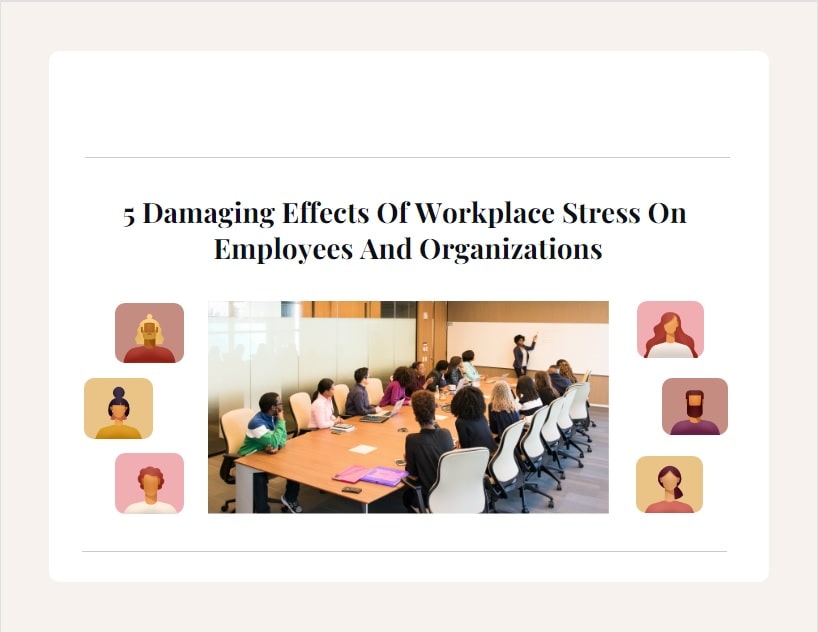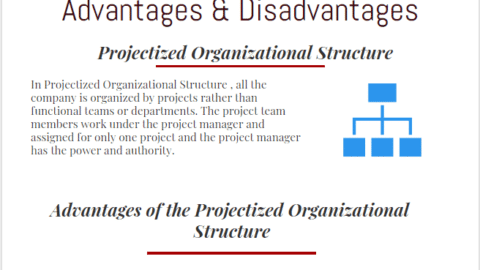5 Damaging Effects Of Workplace Stress On Employees And Organizations
Stress is an unfortunate side effect of modern living, and its effects can be far-reaching for both employees and employers. Everything from the health of your workforce to their performance and your company’s budget can be affected. What are the consequences of a stressful workplace and are there ways to ease the stress? Find out in this guide to 5 damaging effects of workplace stress on employees and organizations and stress management in the workplace.
Table of Contents
Health Impacts on Employees Without Stress Management in the workplace
Stress can cause the body to go into a ‘fight-or-flight’ mode. This, in turn, disrupts the natural balance of various hormones.
Cortisol and adrenaline levels, especially, begin to soar. Research has shown that this is how stress can cause mental health problems and even physical ailments.
Mental Health Implications
Severe stress can take its toll on your employees’ mental health. Possible consequences are burnout, feelings of anxiety, and even depression.
The reason for these negative effects is usually too heavy a workload, unrealistic demands on your employees, or an unhealthy work-life balance.
But there are several ways to reduce workplace stress and improve your employee’s mental well-being.
One of these is to recruit temporary staff to lessen the workload at busier times or offer more flexible work hours.
The latter can be achieved through a remote work option or even a hybrid work model of remote and in-office work.
Physical Health Consequences
If you think some workplace anxiety is all you’ll have to deal with, think again. Severe stress doesn’t just affect your staff’s mental state, but also their physical health.
It’s widely known that continuous stressful situations can cause physical health problems.
These include worsening chronic conditions like migraines, an increased risk of cardiovascular issues, and even a weakened immune system.
This means unhappy employees and time off work.
But that time off will mean an even bigger workload waiting for them when they return. Because the underlying causes of the stress have not been addressed, the resulting medical issues will be harder to treat.
Effects of Workplace Stress on Employee Performance
Anything that can affect the physical and mental health of your staff, will also affect their performance at work.
Ongoing workplace stress leads to a decrease in productivity and efficiency, as well as impaired decision-making and problem-solving abilities.
But this doesn’t just affect the employees who are suffering from stress. It very quickly affects everyone in the company. Here’s how and why that happens.
The Entire Team Suffers
When stressed-out staff are unable to competently perform their duties, their colleagues have to pick up the slack.
And when those stressed workers need time off to handle resulting health issues? The remaining staff have to take on more work – thereby increasing their stress.
It’s a vicious cycle, and before long, it’ll cause havoc with your entire team’s performance.
It also gives inaccurate data for your HR department to work with. Without getting to the root cause of poor performance metrics, they’ll be at a loss as to how to improve the situation.
This means that before long, the organization as a whole will start to show signs of strain.
Organizational Consequences of Workplace Stress
In the long term, the increased absenteeism due to mental instability or health issues will have one of two effects.
Your employees will leave the company in search of a less stressful work environment. Or you’ll be forced to let them go because of poor performance.
Therefore, both voluntary and involuntary turnover rates will rise. This is why many corporations are investing in wellness programs for their staff. They’re all trying to increase employee retention.
Either way, higher employee turnover rates will negatively impact your organization. And once again, there are two possible outcomes – a blow to your reputation or a burden on your budget.
Can you afford these results?
Unexpected Financial Costs
The financial costs of workplace stress include:
- Increased healthcare expenses for stress-related conditions
- Higher worker compensation claims
- Decreased profitability and revenue
- Recruitment costs of replacement staff (even if temporary)
Sullied Reputation and Brand Image
The damage to your organization’s reputation and brand image will:
- Diminish trust in your brand
- Tarnish your reputation as a happy work environment
- Reduce your employees’ net promoter score
- Make it more difficult to attract and retain top talent
- Increase negative employee reviews
Strategies for Addressing Workplace Stress
In any workplace, be it a small business or a large corporation, a certain degree of stress is par for the course. This is often part of what motivates employees to work harder and do better.
However, when it is no longer a cause for motivation, it becomes damaging.
The good news is, you’re not powerless to stop the rollercoaster of the effects of workplace stress. You can take action today, and stem the tide of stress’s damaging effects on your staff and your business.
Here are 5 strategies to avoid the negative results of workplace stress:
- The first few months of starting a new job can be very stressful. Help your new hires survive the demands of their new roles by creating a supportive environment.
- Provide on-site stress management resources and support.
- Give free subscriptions to wellness apps, and similar mental health-boosting institute perks and rewards.
- Establish an inclusive work environment, where everyone feels confident enough to make their voice heard.
- Encourage a healthy work-life balance, by implementing remote or hybrid work models. Alternatively, offer more flexible work hours.
- Encourage stress reduction techniques: Teach employees various stress reduction techniques such as deep breathing exercises, meditation, or mindfulness practices. These techniques help individuals manage stress in the moment and promote relaxation.
- Lead by example: Managers and leaders should lead by example by managing their own stress levels and demonstrating healthy coping mechanisms and stress management in the workplace. When leaders prioritize self-care and stress management, it sets a positive tone for the entire organization.
- Regularly assess and adapt: Continuously evaluate the effectiveness of stress management strategies in your workplace. Seek feedback from employees, track metrics related to stress and well-being, and make adjustments as needed. Different approaches may work better for different teams or individuals, so staying flexible and responsive is important.
Irwin Michael Reston is an expert who has more than 30 years of experience in optimizing businesses, inspiring individuals and improving human resources departments. He established the BlueLight Consulting Limited to provide learning and training service worldwide.










